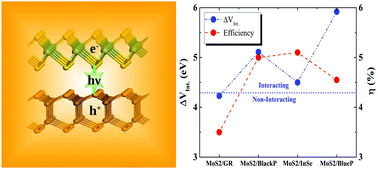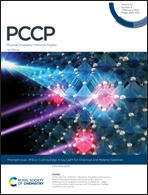Role of van der Waals interaction in enhancing the photon absorption capability of the MoS2/2D heterostructure†
Abstract
van der Waals (vdW) interaction-based heterostructures are known for enhanced photon absorption. However, the origin of these phenomena is not yet completely understood. In this work, using first-principles calculations, we provide a comprehensive study to show the effect of vdW interactions on the optical and electrical characteristics of the device and its origin. Herein, MoS2/2D (where 2D varies as graphene, black and blue phosphorene, and InSe) vdW heterojunctions are considered as model structures. The change in the band gap of the heterostructures is because of hybridisation and the non-linearity of the exchange–correlation functional. Hybridisation is correlated with strain and the difference in interstitial potential between layers of the heterostructure and the vacuum level. Significantly, the estimated values of energy conversion efficiency are high in the case of MoS2/InSe and MoS2/BlackP vdW heterostructures as compared to MoS2/GR and MoS2/BlueP, suggesting their potential application in efficient and atomically thick excitonic solar cell devices.

- This article is part of the themed collection: 2020 PCCP HOT Articles


 Please wait while we load your content...
Please wait while we load your content...